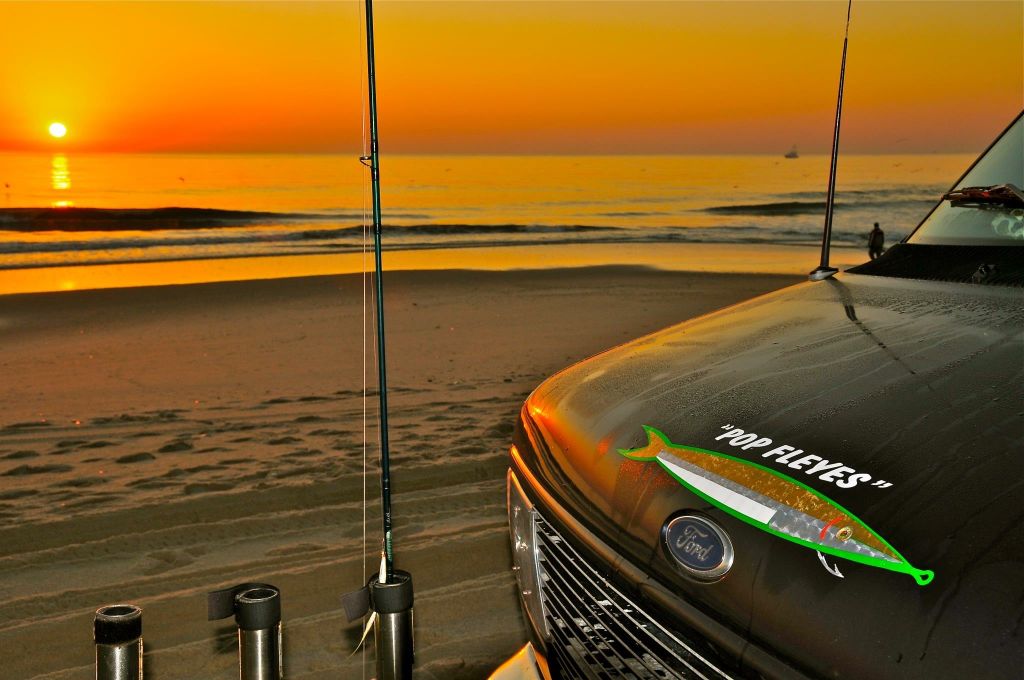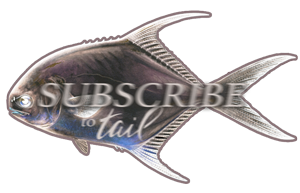Story by Pete Barrett
Photos by Pete Barrett and Bob Popovics
Many coastal fly anglers consider surf fishing to be the ultimate challenge. Fortunately, most of us live within a coffee-mug drive from some of the best surf fly fishing opportunities in the world. Down South, the snook is king, while Up North the striped bass wears the crown. There’s a supporting cast of bluefish, mackerel, trout, and jacks.
Bob Popovics is one of the best at the game of surf fly fishing. He’s been at it for more than 50 years and lives only minutes from New Jersey’s Island Beach State Park, a favorite for striped bass hunters. His surf experience also includes time at surf fly fishing haunts like Martha’s Vineyard, Montauk, and the Outer Banks.
 Just back from Vietnam in 1970, the young Marine was eager to get on with his life and get back to fishing with his dad and working at his family’s Shady Rest restaurant in Bayville, New Jersey. A lunch get-together with high school buddies Jimmy Magee and Butch Colvin (whose dad owned the iconic Cap Colvin’s Tackle in Seaside Park), was the first step in a lifelong fly fishing journey that has made Bob one of the most influential fly tiers of the second generation of saltwater fly fishing pioneers.
Just back from Vietnam in 1970, the young Marine was eager to get on with his life and get back to fishing with his dad and working at his family’s Shady Rest restaurant in Bayville, New Jersey. A lunch get-together with high school buddies Jimmy Magee and Butch Colvin (whose dad owned the iconic Cap Colvin’s Tackle in Seaside Park), was the first step in a lifelong fly fishing journey that has made Bob one of the most influential fly tiers of the second generation of saltwater fly fishing pioneers.
The three buddies arranged a trip off Harvey Cedars to jig weakfish, but when bluefish crashed the party, Butch grabbed a fly rod and began casting. “I thought that was pretty cool, and wanted to learn more about fly fishing, so the next day Butch took me to Cap Colvin’s to buy my first fly rod, reel and line,” Popovics says. “I was hooked. It was like therapy, and the process of learning to cast and catch fish was soothing, and great fun. I fished with the fly rod as often as I could.”
Later that winter, Butch gave Bob a cardboard beer flat filled with a fly tying vise, bobbin, thread, and some feathers and bucktail, and said, “You’re going to learn how to tie flies.” Back then, there wasn’t much information about saltwater fly tying, but like the promise of a full moon at high tide, a new organization called the Salt Water Fly Rodders of America (SWFROA) brought a fresh level of excitement to coastal fly fishers with an exchange of information, techniques, tackle, and fly tying. Bob was an eager student.
Annual get-togethers were sponsored by SWFROA and its chapters at places like Tilghman Island, Maryland; Key West, Florida; Newport, Rhode Island; and Sag Harbor, New York. Bob attended one on North Carolina’s Outer Banks, where he met Lefty Kreh, who became a good friend and mentor. SWFROA had many well known fly anglers on its board of directors, but Fred Schrier of Toms River, New Jersey, was the dynamo, “the juice,” that drove the new organization.
“I owe a lot to Fred,” Popovic says, “because he was a great motivator, always encouraging me to try new things, and he helped introduce me to so many people like Mark Sosin, Poul Jorgensen, Bub Church, and many others who generously gave me advice and support. Fred’s really the guy who gave me the biggest boost.”
“Surf fly fishing is a very visual experience, and to be good at it you have to be an observer, be aware of your surroundings, the type of beach, the breeze, the currents, and beach structure. Watch everything that happens all around you. Before you make the first cast, walk up to the beach, wait a few moments and observe. Watch the wave sets, get the feel of the rhythm of things before you start fishing. Before I make the first cast I check out the water for signs of bait, cloudy and clear water edges, the formation of bars and points, the location of white water and calm water, and the types of birds in the area. You need patience to be an observer, but it makes you a better fly fisherman.”
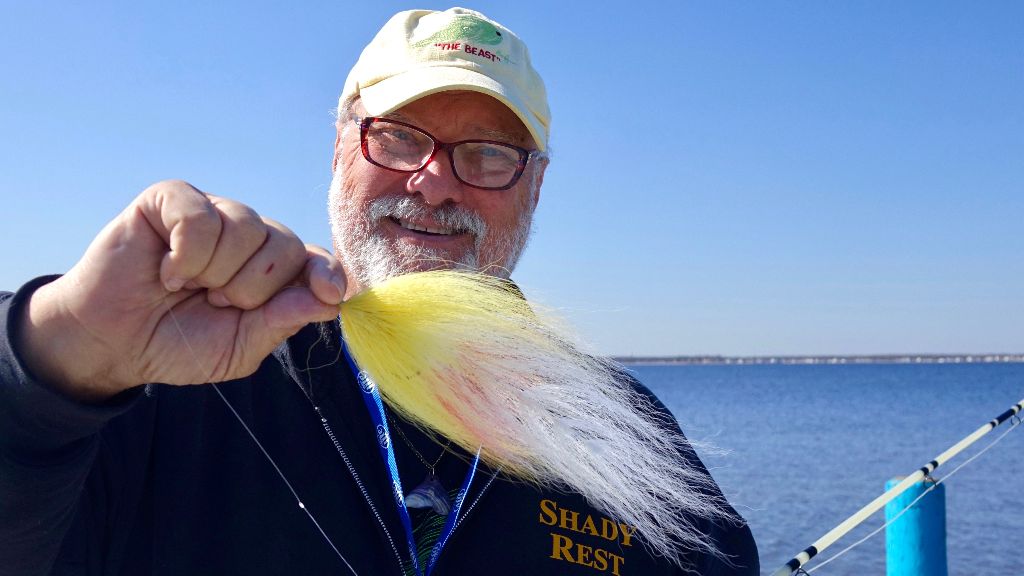 Bob likes to keep things simple. He may have plenty of fly gear and equipment in his beach buggy, but keeps only the bare essentials in a shirt or jacket pocket when he’s standing at the water’s edge fishing. “I always have my stripping basket, and like to use a Velcro belt, which is so much easier to get on and off than a buckle-type belt. My pliers are on my wading belt. I pare down what I need to just a few flies and essentials. Instead of taking 20 of each type of pattern, such as crab flies, or bucktail Deceivers, or Jiggies, I take maybe three of each so I have enough on hand to replace a broken-off or fish-chewed fly. I like soft fleece wallets that fit into my shirt pockets to keep a supply of favorite flies close at hand.”
Bob likes to keep things simple. He may have plenty of fly gear and equipment in his beach buggy, but keeps only the bare essentials in a shirt or jacket pocket when he’s standing at the water’s edge fishing. “I always have my stripping basket, and like to use a Velcro belt, which is so much easier to get on and off than a buckle-type belt. My pliers are on my wading belt. I pare down what I need to just a few flies and essentials. Instead of taking 20 of each type of pattern, such as crab flies, or bucktail Deceivers, or Jiggies, I take maybe three of each so I have enough on hand to replace a broken-off or fish-chewed fly. I like soft fleece wallets that fit into my shirt pockets to keep a supply of favorite flies close at hand.”
He also keeps a spool of 16-pound tippet handy, and another of 12-pound for very clear water. He usually doesn’t use a heavy mono bite tippet. If blues show up, he has a screw-top tube container in his pocket (like the kind that hold cigars), with 8-inch wire leaders tied with a haywire loop at one end to attach to the tippet. The open end is then haywired to the fly.
“Most of the time I know what to expect when I hit the beach, so if the mullet are running, I take mullet patterns and don’t bother loading myself down with a bunch of flies that probably are not appropriate,” Popovics says. “I do like to have a color selection on hand in case I need to change from a bright fly to dark one, and same goes for short and long patterns.”
Bob favors a 9- or 10-foot, single-hand rod, and says, “Although I’ve tried, I haven’t gotten into the two-hand casting style, and prefer to use single-hand rods most of the time. I like a rod that is not an ultra-fast design. In my consulting work with fly rod manufacturers and in teaching fly casting, I’ve come to like fly rods that have a tad more bend in the butt section as compared to stiff, ultra-fast taper fly rods. Some of my favorites include designs by St. Croix that give the surf fly caster better control of the fly presentation when mending the line or when lifting the line to make a quick cast to reposition the fly. This is an essential feature for any good surf fly rod.”
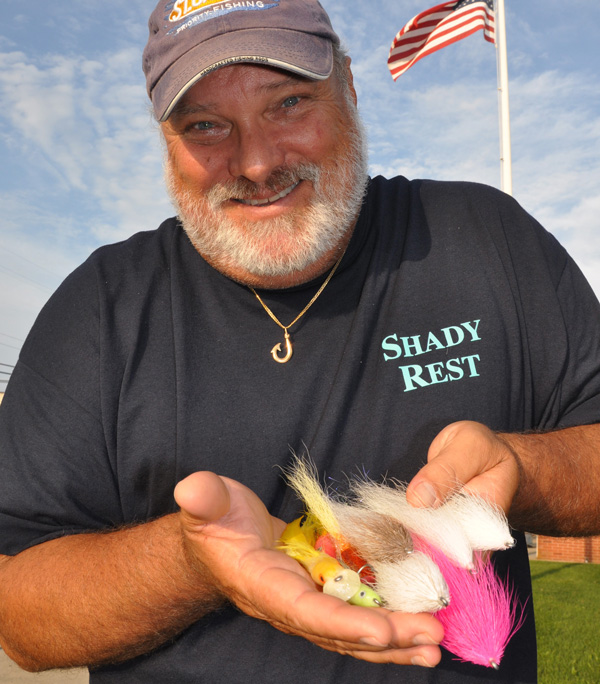 “When fly fishing the surf, it’s common to retrieve the fly all the way to the rod tip. To quickly and efficiently make the next cast, I like a short, blunt-head line that will load the rod with less line outside the tip. You’re looking to make as few false casts as possible, so a short compact head will load the rod quicker and more efficiently. Use the resistance of the water to help load the rod as you lift to make the backcast, shoot some line on the backcast, then shoot the works on the forward cast. Depending on wind you may need another false cast to reach out to the fish, but always strive for the fewest number of false casts. The goal is to lift for the backcast, shoot, and shoot again on the forward cast.”
“When fly fishing the surf, it’s common to retrieve the fly all the way to the rod tip. To quickly and efficiently make the next cast, I like a short, blunt-head line that will load the rod with less line outside the tip. You’re looking to make as few false casts as possible, so a short compact head will load the rod quicker and more efficiently. Use the resistance of the water to help load the rod as you lift to make the backcast, shoot some line on the backcast, then shoot the works on the forward cast. Depending on wind you may need another false cast to reach out to the fish, but always strive for the fewest number of false casts. The goal is to lift for the backcast, shoot, and shoot again on the forward cast.”
“A floating line is my first choice when selecting a fly line. Most fly anglers can dependably cast 50 to 70 feet, and at that distance most beaches will be about 5 to 7 feet deep. A striped bass can easily see the fly at that depth and if you need to go deeper, a weighted fly like a Jiggy or a Clouser Minnow will get deep enough,” Popovics says.
A floater with a short intermediate head is his second choice. “You want to be able to pick up line and recast if necessary, and this is still possible with an intermediate sink tip fly line. You need to do this if the fish moves away from you after you’ve made a cast, or if the fish veers off at an angle from its original swimming direction.”
“A floating line only behaves badly and makes a poor presentation in the surf when you allow the line to be carried away by a breaking wave. You can overcome this by working the line in between the waves, letting it ride and fall with the waves as they roll to the beach. Watch the sets. After six or seven waves, there’s usually a calm area before the next set starts and you can make a nice presentation into this calm water.”
Bob recommends that every surf fly angler learn the skill of mending line. This quick, circular flip motion of the rod tip adjusts the line’s position in a current or wave to keep the fly tracking nicely. If the wave action makes it impossible to control the fly, he uses a roll cast, then lifts for a backcast, and shoots a forward cast to reposition the fly in calm water. “Rod handling becomes second nature, and after awhile you don’t even think about it. The line mending and lifting just become automatic responses to the motions and actions of the waves.”
We all dream of catching a fish so big we won’t have to fib about it, but typical surf-caught striped bass run from schoolies to teen-size and maybe into the 20-pound range. A 30-pounder is an astonishing catch. Even the biggest striped bass will not take too much line, so Bob prefers lightweight large-arbor reels that can hold about 150 yards of backing. “You don’t need a huge reel. The weight of a big reel gets tiring and feels like you have an anchor under the rod. More important is a large spool diameter that retrieves line quickly. Keep in mind that most fish I can play by simply bringing the line in by hand and dropping it into the stripping basket.
“Most reels today are saltwater worthy,” he says, “and it’s probably more important to consider which hand you use to crank the line in. Right or left, the dominant hand is your best choice. A right hander will reel faster, longer, and more smoothly with the right hand; the opposite is true for a southpaw.”
It’s natural to want to walk into the surf up to your knees, but Popovics prefers being higher on the sand because many times the bass will be right in the wash. When fly fishing a beach, the currents and structure are important. The basic current is from the incoming and receding waves, but there are also beach currents generated by wind that often run along the beach. These areas can be worked by letting the fly swing in the current, mending the line as needed to keep in touch with the fly and not let the waves pull line and cause an erratic retrieve and slack.
Bob suggests surgically casting along the beach structure just like a trout fishermen in a small stream. The bass aren’t everywhere; they hold and travel along definite structure such as a slough between the beach and a sand bar, a cut in a sand bar, a point of the beach with white water along its sides, the edges of clear and cloudy water, and also the calm water. “Work all of it,” he says. “Use wind and currents to your advantage when walking the beach. Keep the wind off your non-casting side when possible, or walk with the current a few steps in between casts.”
Bob’s good friend Lou Tabory told him, “There’s no substitute for time on the water,” and Bob echoes that with more good advice, “Even a fishless morning can still be a great day because of the experience earned and knowledge gained. Count the hours, not the fish. Be an observer, look for things, think about what’s going on around you, work the structure, and remember that time on the water builds casting and fishing skills.”
As the premier fall surf fly fishing builds, Bob uses specific fly patterns based on what bait is prevalent as the season matures from September through November. For the early fall, he’s usually throwing Siliclones and Bob’s Bangers to imitate mullet, and Jiggies and Surf Candies to imitate rain fish. When bigger baits are in the surf, his go-to patterns include bucktail Deceivers, The Beast, and Spread Fleyes. Later in the fall, when the sand eel invasion has hordes of the slender baits invading the beach, he’ll switch to longer but skinny Jiggy Fleyes.
One last tip, one of Bob’s favorite fall times to fly fish is the start of a fresh northeaster before the water gets all roiled up and murky, when it’s still clear. “The bass go on binge feed,” he says, “and if the water is real rough, I’ll use a 300 to 400-grain sink tip line to cut through the turbulence.”
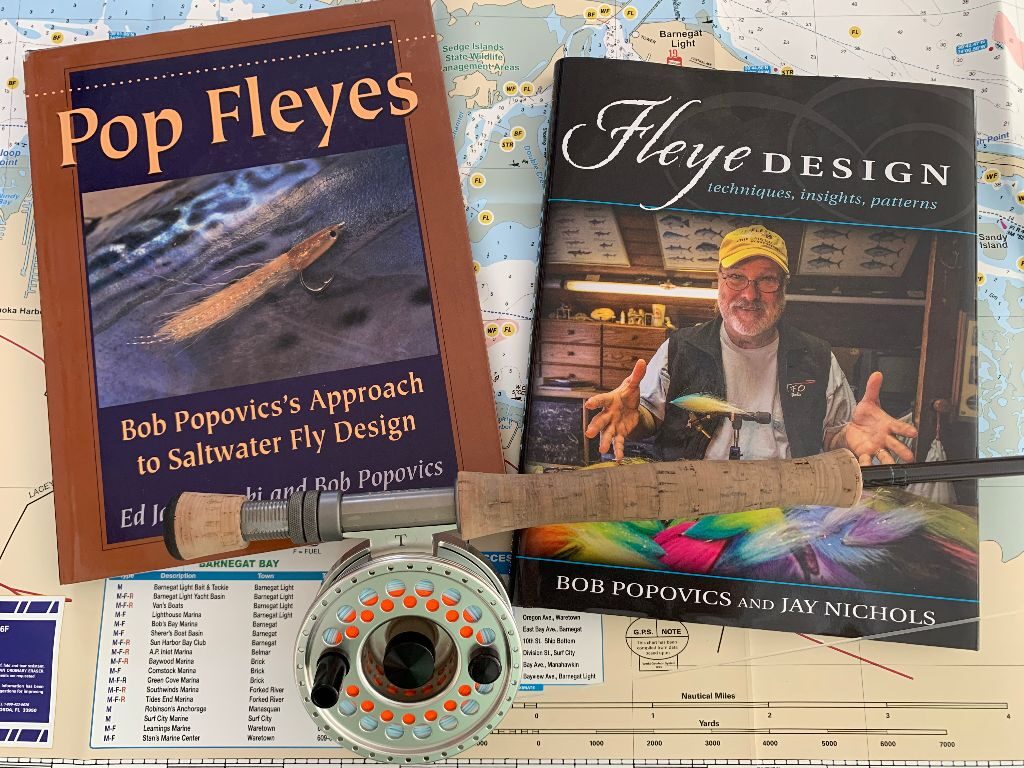
Surf fly fishing is popular for many reasons, including its simplicity and nearness to home—and equipment doesn’t have to cost an arm and a leg. It’s exhilarating when a full-blown bluefish blitz erupts, yet serene and calm as the sun ignites the dawn and striped bass begin to swirl at bait in the trough. Fly fishing the surf is a lifelong adventure that has captured fly fishing pioneers dating back to Rhode Island’s Harold Gibbs, New Jersey’s Cap Colvin, and Maryland’s Lefty Kreh—and it now inspires today’s new generation of fly fishers.
Read more great articles like this one and get expert tips from the legends of saltwater fly fishing in the pages of Tail Fly Fishing Magazine. If you love saltwater fly fishing and wish to improve your game, support conservation causes and become part of a small but incredible community, then subscribe to Tail Fly Fishing Magazine today.
You might also like:
More Articles by Pete Barrett:

